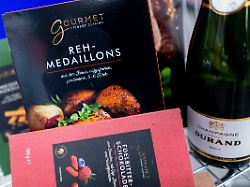Race before Christmas
Supermarket chains attract customers with premium ranges
December 23, 2023, 5:02 p.m
Listen to article
This audio version was artificially generated. More info | Send feedback
Retail chains are facing a special challenge this year. Inflation and economic uncertainty are inhibiting the desire to buy. This is why many consumers want to save on their Christmas spending. When comparing advertising, one thing in particular stands out.
Consumers are once again faced with a dilemma. Many decisions have to be made in the weeks before Christmas. What do you give your loved ones as gifts? What’s on the menu in the days surrounding Christmas Eve?
One question is almost overlooked: Where is the shopping cart filled with delicacies and supplies? There are probably few days a year when Aldi, Lidl, Rewe, Edeka and other chains compete so fiercely. “Christmas madness – ho, ho get it,” is how Lidl advertises its savings coupons. Aldi Nord promises “Christmas savings with the best prices” and Edeka “low prices & sky-high enjoyment combined in the heart”.
Retail chains are facing a special challenge this year. Inflation and economic uncertainty have been inhibiting the desire to buy for months. Many surveys show that consumers want to save on their Christmas spending. According to forecasts by the German Trade Association (HDE), the industry as a whole can only expect a small plus in nominal terms in the Christmas business, i.e. in November and December, compared to the previous year. Adjusted for inflation, there is a risk of a decline of more than five percent.
The grocery store is therefore making a special effort to spread a good mood in the run-up to Christmas this year. “Many retail companies consciously focus on happiness and conviviality, on the light and contemplative,” says retail expert Jörg Funder from Worms University. Because the past few years have been characterized by so much bad news, retailers have hit consumers’ nerves.
Conditions are good despite the mood of crisis
Christmas business is very important for the food retail sector. According to the food trade association, December is the highest sales time of the year. During Advent, weekly sales increase from around 3.5 billion to up to 4.5 billion euros up to the week before the Christmas holidays. Last year, according to market researchers at GfK, particularly above-average sales were achieved with confectionery, wine and sparkling wine, hot drinks and spirits in the two weeks before Christmas.
Traditionally, the conditions are good despite the mood of crisis. This is also because customer demands increase during the Christmas season. “We want to pamper our families and do something good for ourselves. That’s why people buy more than usual and more expensive products in order to have a nice celebration,” says Martin Fassnacht, trade expert from the WHU business school. “There’s always the symbolic component that people want to impress their families by bringing certain brands to the table.”
When comparing the advertising, it is clear that before the festival, all retail chains highlight their premium ranges. At Lidl you can buy Pacific rock oysters, caviar and Australian lamb shanks from the luxury own brand Sansibar Deluxe. Rewe also offers recipe suggestions, for example for cod fillets with saffron foam with snow peas or polenta with red cabbage and orange salad and turkey breast fillet. The Edeka subsidiary Netto tempts with roast beef and vegan nut roasts. Everyone has a large selection of drinks to toast in front of the Christmas tree. The demand is certain: According to a Yougov survey, 37 percent of Germans want to drink sparkling wine at the festival.
Something else can encourage grocers
Traditionally, supermarkets such as Rewe and Edeka can particularly benefit from the Christmas business in December. “During the Christmas week, a typical discounter makes around 30 percent more sales, a supermarket up to 60 percent more than an average week of the year,” says retail expert Funder. However, as a result of inflation and changes in shopping behavior, discounters have recently been able to catch up. “This year, customers were particularly price sensitive, and the discounters benefited from this,” says Michael Gerling, managing director of the retail research institute EHI.
It’s not just the search for the right Christmas meal that draws customers to the grocery stores before the holiday. According to a study by GfK, many people also look for presents there. Food is one of the most popular gift categories. Wines, spirits and chocolates are particularly in demand. The non-food sector also plays an important role. Kitchen items, baking accessories, toys and clothing are particularly popular. This has one main advantage for customers: the markets have everything under one roof – banquets and last-minute gifts.
Something else can encourage grocers: the slight signs of relaxation in consumer prices offer at least some reason for a more hopeful outlook on the new year. Kai Hudetz from the Institute for Retail Research believes that Christmas business will be better than last year. While 32 percent of people wanted to save on Christmas dinner in 2022, this year the figure is only 24 percent. The savings are significantly behind other expenses, for example for Christmas presents or the Christmas tree. The feast is obviously sacrosanct for many people.
